Investigation of Intermetallics Formation and Joint Performance of Laser Welded Ni to Al
Abstract
1. Introduction
2. Materials and Methods
3. Results
3.1. Evaluation of Weld Quality
3.2. IMCs Formation
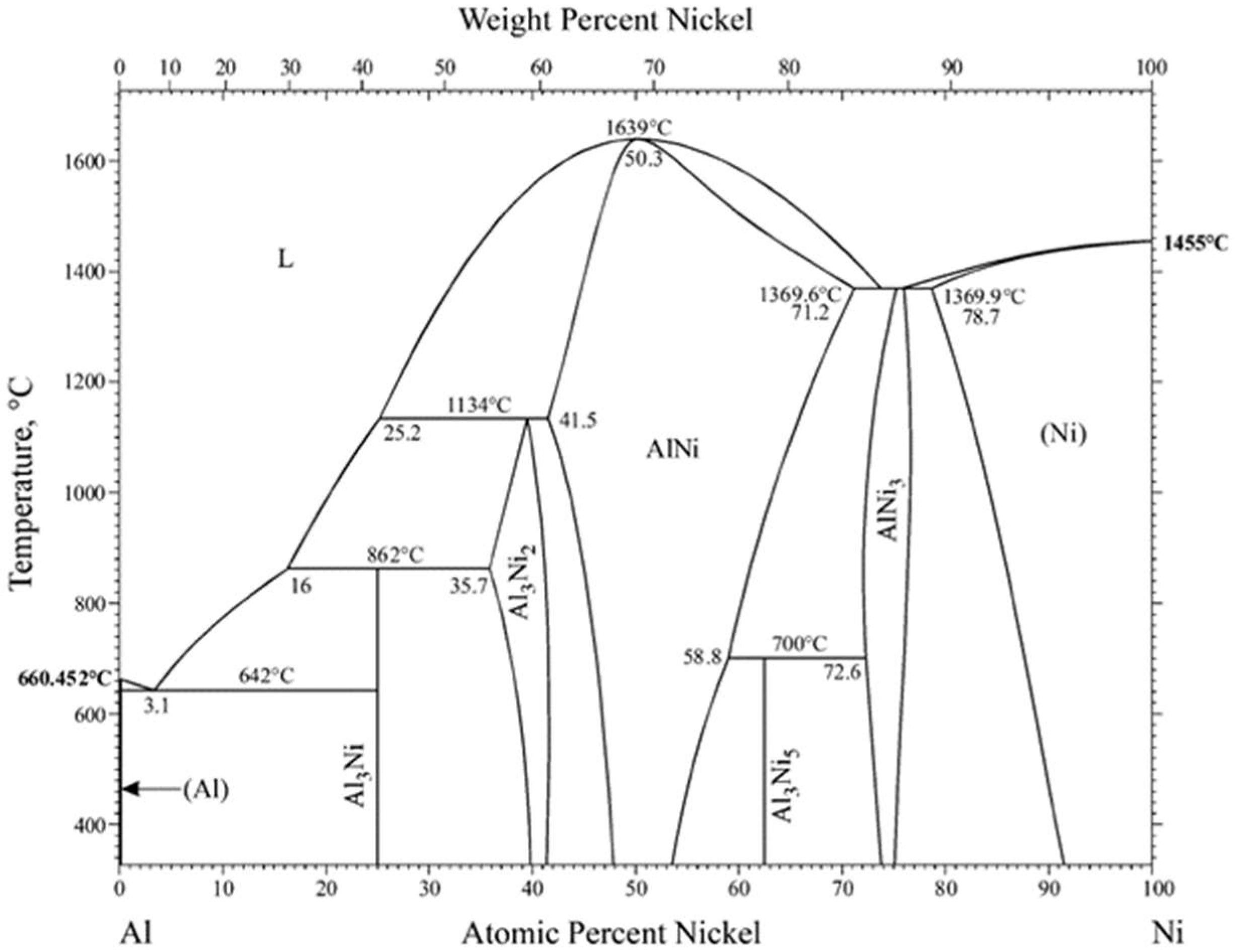

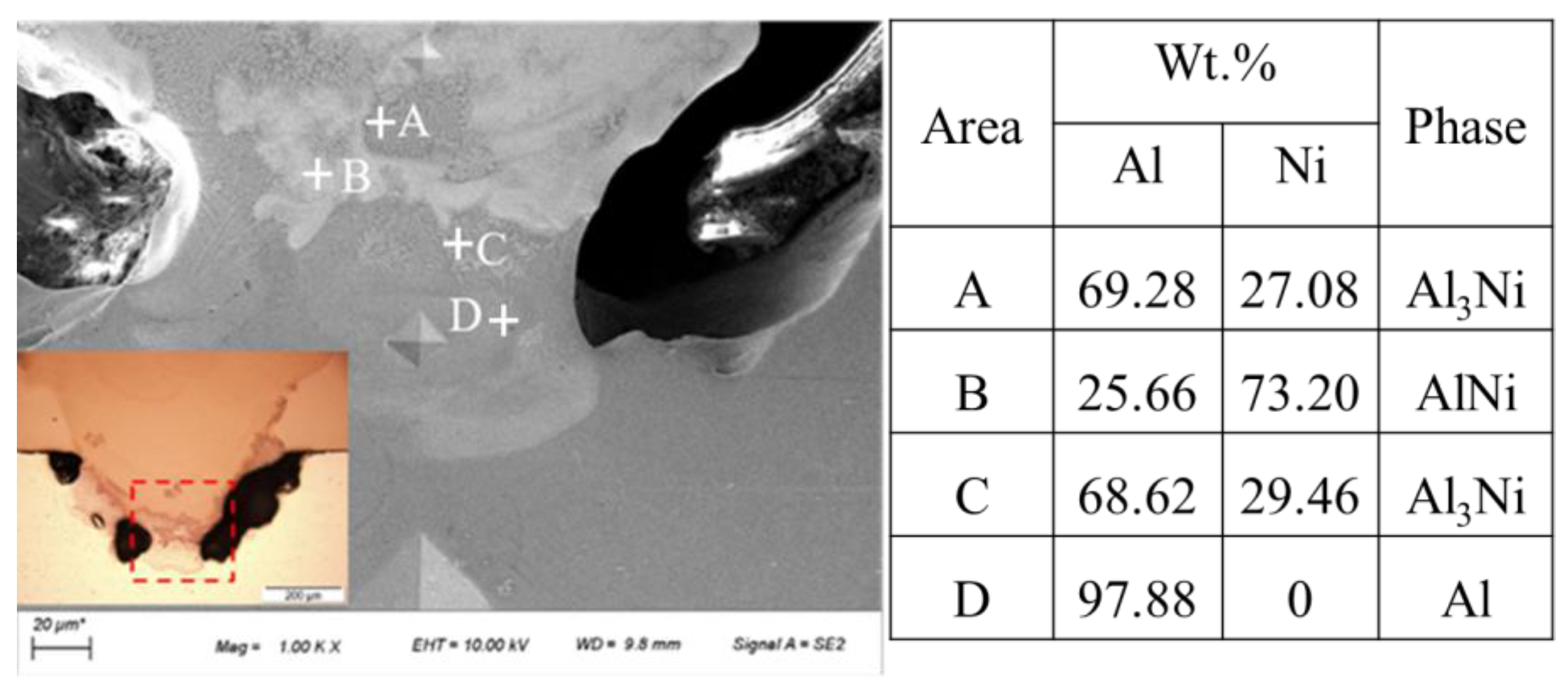
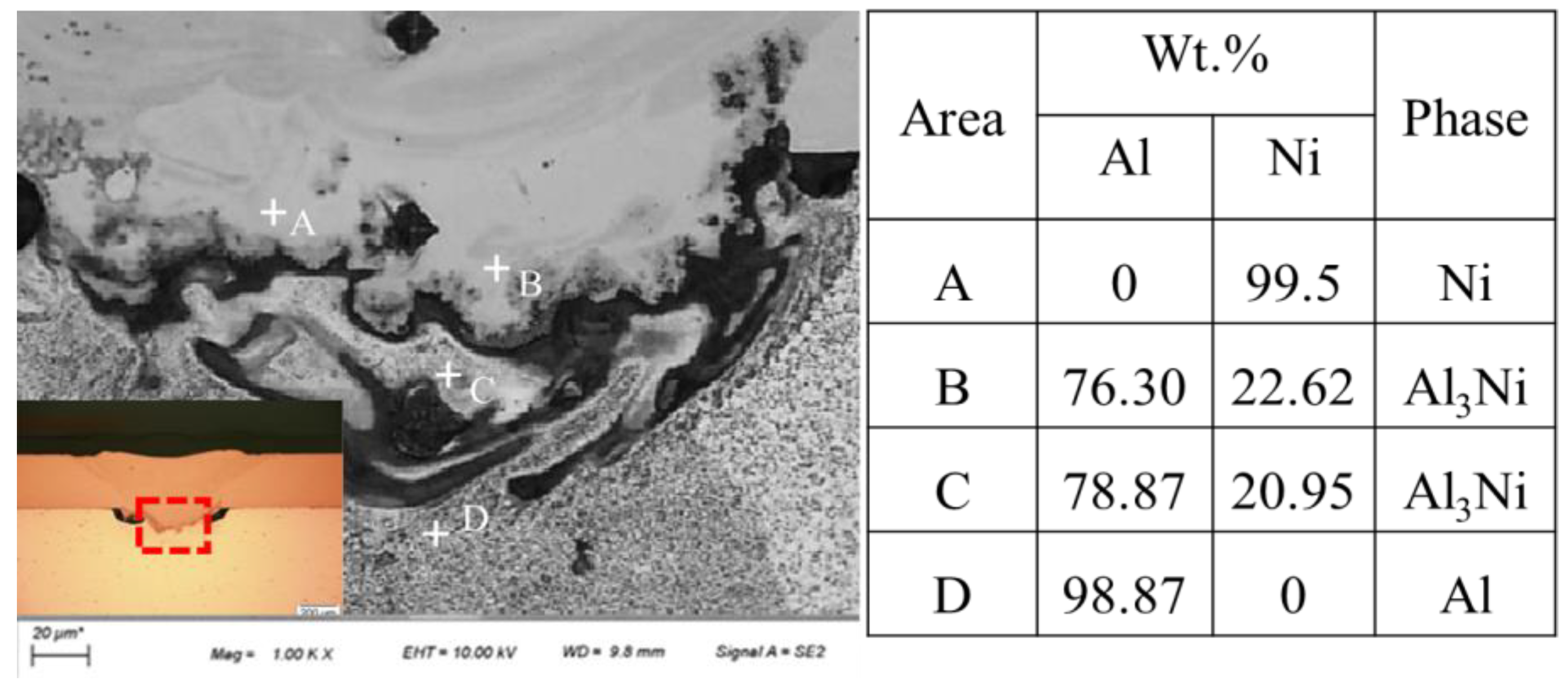
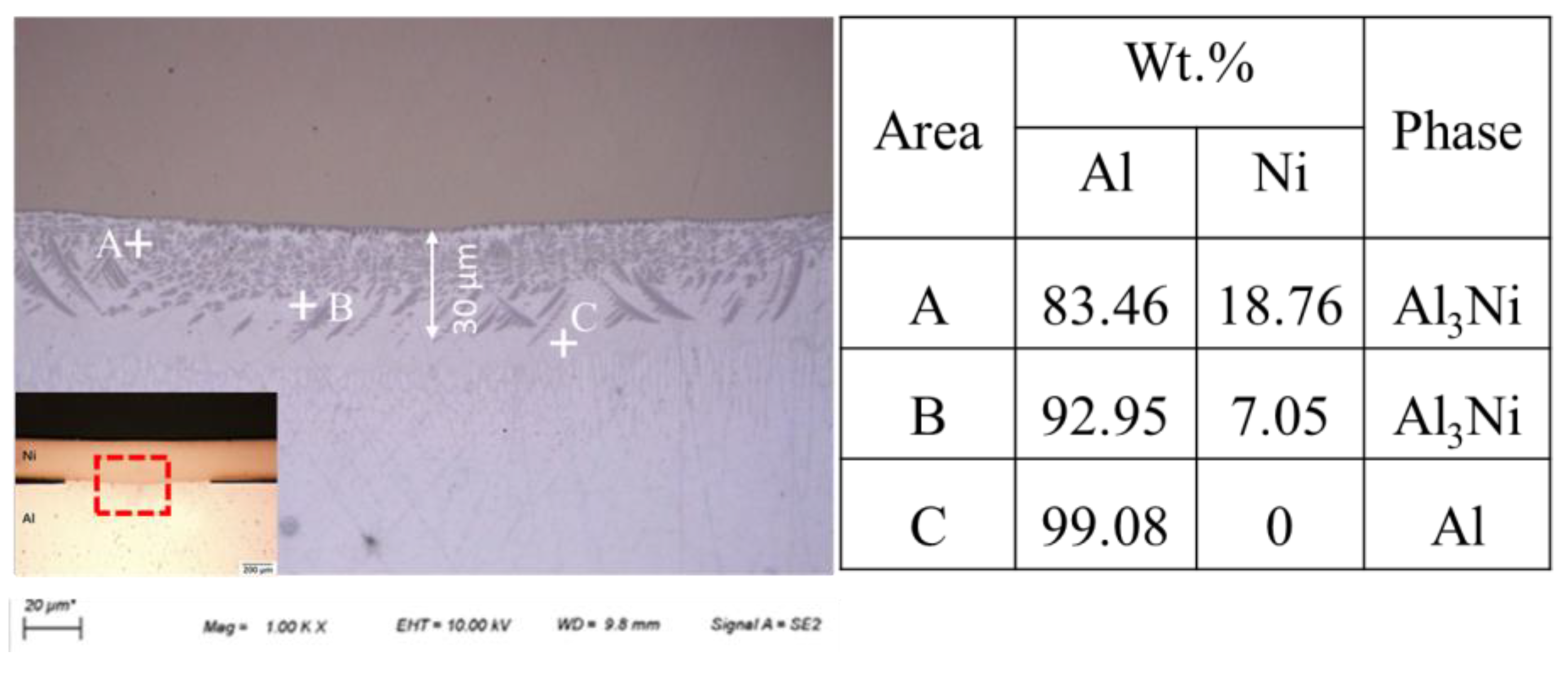
3.3. Microhardness

3.4. Joint Strength Analysis
4. Conclusions
- Deep penetration and overheating low-melting-point Al is the main reason causing the formation of pores at the Ni-Al interface and severe mixing of the Ni and Al in the melting pool.
- It is critical to control the penetration depth through the selection of the operation mode of the laser, as well as the optimization of process parameters, so that the formation of defects and undesired IMCs (AlNi3 and AlNi) could be avoided.
- The IMCs show a significant effect on the hardness of the weld, whereas the defects and brittle IMCs jointly degrade the weld to withstand the shear force and peel force.
- It is feasible to achieve a weld-braze joining condition using a defocused CW laser beam, through which defects-free and strong Ni-Al joint can be obtained. Due to the nature of high peak power resulting in deep penetration, it is difficult to obtain comparable joint quality using a pulsed laser.
Author Contributions
Funding
Institutional Review Board Statement
Informed Consent Statement
Data Availability Statement
Conflicts of Interest
References
- Kumar, N.; Das, A.; Dale, T.; Masters, I. Laser wobble welding of fluid-based cooling channel joining for battery thermal management. J. Manuf. Process. 2021, 67, 151–169. [Google Scholar] [CrossRef]
- Zhao, J.Z.; Li, H.; Choi, H.; Cai, W.; Abell, J.A.; Li, X.C. Insertable thin film thermocouples for in situ transient temperature monitoring in ultrasonic metal welding of battery tabs. J. Manuf. Process. 2013, 15, 136–140. [Google Scholar] [CrossRef]
- Chen, W.H.; Che, Y.B. Design of Lead-acid Battery Management System. Sci. Net 2014, 533, 331–334. [Google Scholar]
- Das, A.; Li, D.; Williams, D.; Greenwood, D. Joining technology for automotive battery systems manufacturing. World Electr. Veh. J. 2018, 9, 22. [Google Scholar] [CrossRef]
- Brand, M.J.; Schmidt, P.A.; Zaeh, M.F.; Jossen, A. Welding techniques for battery cells and resulting electrical contact resistances. J. Energy Storage 2015, 1, 7–14. [Google Scholar] [CrossRef]
- Schweier, M.; Heins, J.F.; Haubold, M.W.; Zaeh, M.F. Spatter formation in laser welding with beam oscillation. Phys. Procedia 2013, 41, 20–30. [Google Scholar] [CrossRef]
- Wang, Y.; Qin, W.Z.; Li, Y.; Tang, D.; Wang, L. Al/Ni reactive multilayer films enhancing the properties of plasma induced by nanosecond pulsed laser. Energetic Mater. Front. 2021, 2, 147–153. [Google Scholar] [CrossRef]
- Solchenbach, T.; Plapper, P.; Cai, W. Electrical performance of laser braze-welded aluminum–copper interconnects. J. Manuf. Process. 2014, 16, 183–189. [Google Scholar] [CrossRef]
- Kraetzsch, M.; Standfuss, J.; Klotzbach, A.; Kaspar, J.; Brenner, B.; Beyer, E. Laser beam welding with high-frequency beam oscillation: Welding of dissimilar materials with brilliant fiber lasers. Phys. Procedia 2011, 12, 142–149. [Google Scholar] [CrossRef]
- Das, A.; Butterworth, I.; Masters, I.; Williams, D. Evaluation of key geometrical and mechanical properties for remote laser welded AC-170PX Aluminium joints. J. Manuf. Process. 2019, 14, 1–7. [Google Scholar]
- Ishak, M.; Yamasaki, K.; Maekawa, K. Lap fillet welding of thin sheet AZ31 magnesium alloy with pulsed Nd: YAG laser. J. Solid Mech. Mater. Eng. 2009, 3, 1045–1056. [Google Scholar] [CrossRef]
- Schmalen, P.; Plapper, P. Evaluation of laser braze-welded dissimilar Al-Cu joints. Phys. Procedia 2016, 83, 506–514. [Google Scholar] [CrossRef]
- Zhao, X.H.; Shi, Z.F.; Deng, C.; Liu, Y.; Li, X. The effect of laser offset welding on microstructure and mechanical properties of 301L to TA2 with and without Cu intermediate layer. Metals 2020, 10, 1138. [Google Scholar] [CrossRef]
- Lei, Z.; Zhang, X.; Liu, J.; Li, P. Interfacial microstructure and reaction mechanism with various weld fillers on laser welding-brazing of Al/Cu lap joint. J. Manuf. Process. 2021, 67, 226–240. [Google Scholar] [CrossRef]
- Meco, S.; Ganguly, S.; Williams, S.; McPherson, N. Design of laser welding applied to T joints between steel and aluminium. J. Mater. Process. Technol. 2019, 268, 132–139. [Google Scholar] [CrossRef]
- Chen, S.H.; Yu, G.Y.; Li, S.Q.; Yang, J.; Huang, J.H.; Chen, S.J. Interfacial microstructures and mechanical property of Ni/Al dissimilar butt joint made by laser welding. J. Manuf. Process. 2020, 50, 17–23. [Google Scholar] [CrossRef]
- Kumar, N.; Masters, I.; Das, A. In-depth evaluation of laser-welded similar and dissimilar material tab-to-busbar electrical interconnects for electric vehicle battery pack. J. Manuf. Process. 2021, 70, 78–96. [Google Scholar] [CrossRef]
- Trinh, L.N.; Lee, D. The Characteristics of Laser Welding of a Thin Aluminum Tab and Steel Battery Case for Lithium-Ion Battery. Metals 2020, 10, 842. [Google Scholar] [CrossRef]
- Dimatteo, V.; Ascari, A.; Fortunato, A. Dissimilar laser welding of copper and aluminum alloys in multilayer configuration for battery applications. J. Laser Appl. 2021, 33, 042028. [Google Scholar] [CrossRef]
- Chua, S.F.; Chen, H.C.; Bi, G. Influence of pulse energy density in micro laser weld of crack sensitive Al alloy sheets. J. Manuf. Process. 2019, 38, 1–8. [Google Scholar] [CrossRef]
- Okamoto, H. Supplemental Literature Review of Binary Phase Diagrams: Al-Ni, B-Hf, Ca-Sc, Cr-Sc, Fe-Rh, Hf-Mn, La-Sb, Ni-Re, Ni-Sm, Ni-Zr, Sb-Tb, and Ti-Zr. J. Phase Equilib. Diffus. 2019, 40, 830–841. [Google Scholar] [CrossRef]

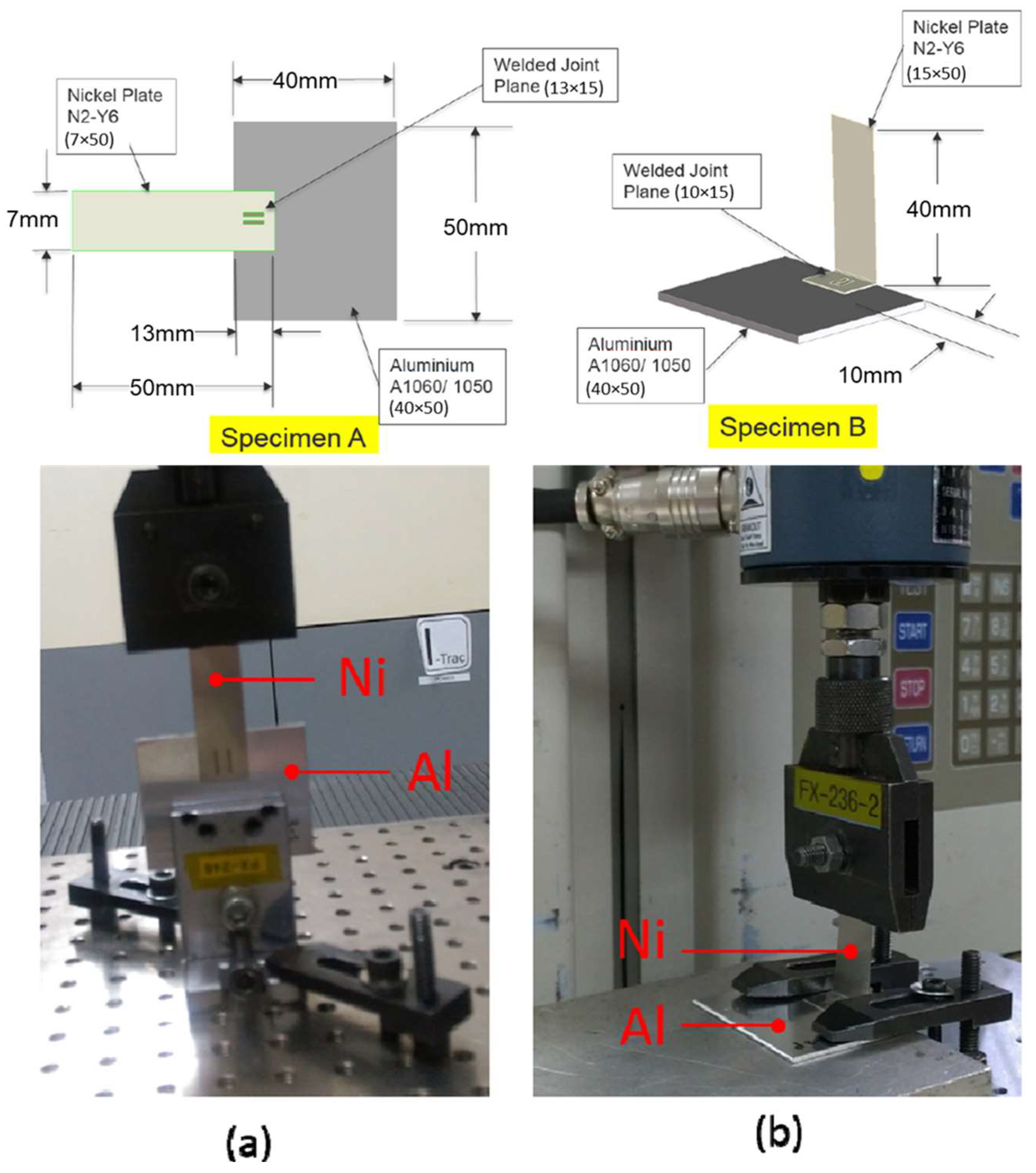

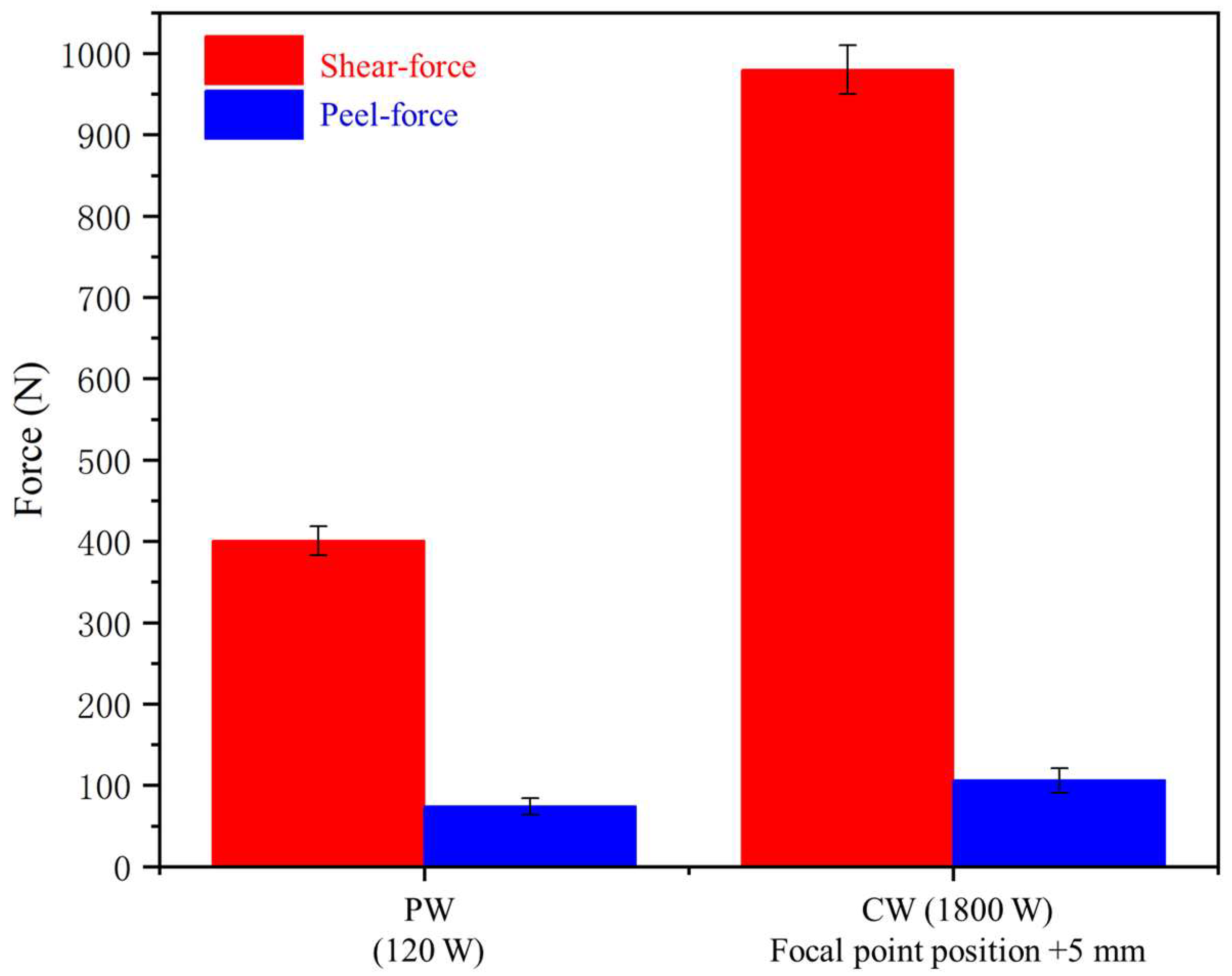
| Material | Chemical Composition (wt. %) | ||||||||
|---|---|---|---|---|---|---|---|---|---|
| Si | Fe | Cu | Mn | Mg | Ni | Zn | Ti | Al | |
| 1060Al | 0.25 | 0.35 | 0.05 | 0.03 | 0.03 | 0.05 | 0.03 | Bal. | |
| Ni200 | 0.02 | Bal. | |||||||
| Material | Melting Point (°C) | Thermal Conductivity (W/m k) | Density (g/cm3) | Hardness (Hv) |
|---|---|---|---|---|
| 1060Al | 660 | 247.0 | 2.70 | 20 |
| Ni200 | 1453 | 82.9 | 8.90 | 140 |
| No. | Laser Source | Average Laser Power (W) | Welding Speed (mm/min) | Pulse Duration (ms) | Pulse Frequency (Hz) | Focal Point Position tp the Top Surface (mm) |
|---|---|---|---|---|---|---|
| (a) | PW | 150 | 800 | 2.5 | 15 | 0 |
| (b) | CW | 1800 | 3600 | - | - | 0 |
| (c) | PW | 120 | 800 | 2.5 | 15 | 0 |
| (d) | CW | 1800 | 3600 | - | - | +5 |
Disclaimer/Publisher’s Note: The statements, opinions and data contained in all publications are solely those of the individual author(s) and contributor(s) and not of MDPI and/or the editor(s). MDPI and/or the editor(s) disclaim responsibility for any injury to people or property resulting from any ideas, methods, instructions or products referred to in the content. |
© 2023 by the authors. Licensee MDPI, Basel, Switzerland. This article is an open access article distributed under the terms and conditions of the Creative Commons Attribution (CC BY) license (https://creativecommons.org/licenses/by/4.0/).
Share and Cite
Cao, L.; Liu, Y.; Chen, H.-C.; Zhang, L.; Sun, H.; Bi, G. Investigation of Intermetallics Formation and Joint Performance of Laser Welded Ni to Al. Appl. Sci. 2023, 13, 1356. https://doi.org/10.3390/app13031356
Cao L, Liu Y, Chen H-C, Zhang L, Sun H, Bi G. Investigation of Intermetallics Formation and Joint Performance of Laser Welded Ni to Al. Applied Sciences. 2023; 13(3):1356. https://doi.org/10.3390/app13031356
Chicago/Turabian StyleCao, Lichao, Yongfeng Liu, Hui-Chi Chen, Li Zhang, Hua Sun, and Guijun Bi. 2023. "Investigation of Intermetallics Formation and Joint Performance of Laser Welded Ni to Al" Applied Sciences 13, no. 3: 1356. https://doi.org/10.3390/app13031356
APA StyleCao, L., Liu, Y., Chen, H.-C., Zhang, L., Sun, H., & Bi, G. (2023). Investigation of Intermetallics Formation and Joint Performance of Laser Welded Ni to Al. Applied Sciences, 13(3), 1356. https://doi.org/10.3390/app13031356






